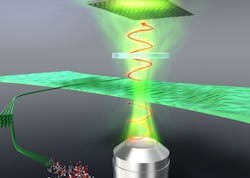A team at the Institute of Scientific and Industrial Research at Osaka University has determined the optical parameters of cellulose molecules with exceptional precision.1 They found that cellulose's intrinsic optical birefringence is high enough to be used in optical displays, such as flexible liquid crystal display (LCD) screens or electronic paper.
Cellulose, a naturally occurring polymer, consists of many long molecular chains. Because of its rigidity and strength, cellulose helps maintain the structural integrity of the cell walls in plants. It makes up about 99% of the nanofibers that comprise nata de coco (a tropical dessert made from coconut water), and helps create its unique and tasty texture.
The team at Osaka University used unidirectionally-aligned cellulose nanofiber films created by stretching hydrogels from nata de coco at various rates. Nata de coco nanofibers allow the cellulose chains to be straight on the molecular level, and this is helpful for the precise determination of the intrinsic birefringence—that is, the maximum birefringence of fully extended polymer chains.
The main application the researchers envision is as light-compensation films for LCDs, since they operate by controlling the brightness of pixels with polarization filters. Potentially, any smartphone, computer, or television that has an LCD screen could see improved contrast, along with reduced color unevenness and light leakage, with the addition of cellulose nanofiber films.
"Cellulose nanofibers are promising light-compensation materials for optoelectronics, such as flexible displays and electronic paper, since they simultaneously have good transparency, flexibility, dimensional stability, and thermal conductivity," says lead author Kojiro Uetani.
Source: https://resou.osaka-u.ac.jp/en/research/2019/20190417_1
REFERENCE:
1. Kojiro Uetani, Hirotaka Koga, and Masaya Nogi, ACS Macro Letters (2019); doi: 10.1021/acsmacrolett.9b00024.

John Wallace | Senior Technical Editor (1998-2022)
John Wallace was with Laser Focus World for nearly 25 years, retiring in late June 2022. He obtained a bachelor's degree in mechanical engineering and physics at Rutgers University and a master's in optical engineering at the University of Rochester. Before becoming an editor, John worked as an engineer at RCA, Exxon, Eastman Kodak, and GCA Corporation.
